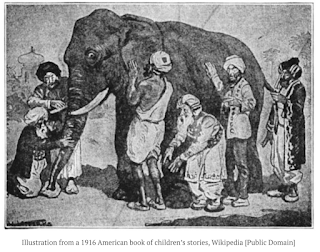The Blind Men and the Elephant
by John Godfrey Saxe
It was six men of Indostan
To learning much inclined Who went to see the Elephant
(Though all of them were blind),
That each by observation
Might satisfy his mind.
The First approached the Elephant
And happening to fall
Against his broad and sturdy side,
At once began to bawl:
"God bless me! but the Elephant
Is very like a wall!"
The Second feeling at the tusk,
Cried, "Ho! what have we here
So very round and smooth and sharp?
To me tis mighty clear
This wonder of an Elephant
Is very like a spear!"
The Third approached the animal,
And happening to take
The squirming trunk within his sands,
Thus boldly up and spake:
"I see," quoth he, "the Elephant
Is very like a snake!"
The Fourth reached out an eager hand
And felt about the knee.
"What most this wondrous beast is like
Is mighty plain," quoth he;
"Tis clear enough the Elephant
Is very like a tree!"
The Fifth who chanced to touch the ear,
Said: "E'en the blindest man
Can tell what this resembles most;
Deny the fact who can,
This marvel of an Elephant
Is very like a fan!"
The Sixth no sooner had begun
About the beast to grope,
Than, seizing on the swinging tail
That fell within his scope,
"I see," quoth he, "the Elephant
Is very like a rope!"
And so these men of Indostan
Disputed loud and long
Each in his own opinion
Exceeding stiff and strong,
Though each was partly in the right,
And all were in the wrong!
From: Nonsense & Commonsense : a child's book of Victorian verse by John Grossman & Priscilla Dunhill, Workman Publishing, 1992.
As a lover of Sherlock Holmes in all his permutations, I feel an affinity for the Victorian times, although I am always grateful that I did not have to fit into either the stuffy manners or the stifling garments of the times. As a lover of poetry, however, I can look upon the Victorian period as a golden age.
As they write in the introduction to this beautifully illustrated volume, "In nineteenth-century America,, poetry was a national pastime. Victorians "rendered" poems in front parlors, at political rallies and family picnics. Parents knew then, as parents know today, that poetry with its click-clack rhyme, rhythm and repetition is the first literature children fall in love with."
The illustrations are all from the years 1880-1920 and are part of the John Grossman Collection of Antique Images. The book design is top-notch. I found each page a delight to look through and the poems both charming and fun and provided a chance to glimpse the innocence of another time and place.
The poem that I chose, seems particularly pertinent for today's media landscape. We have such amazing technology and information resources at our fingertips that we should, theoretically, be able to see issues in all their fullness and complexity. However, human nature being what it is, we are, like the blind men, limited by our vantage point and committed to our point of view, regardless of how accurate it might (or might not) be.
The poem has a final verse that was not included in the text of the book. It reads:
MORAL,
So, oft in theologic wars
The disputants, I ween,
Rail on in utter ignorance
Of what each other mean;
And prate about an Elephant
Not one of them has seen!
I found that verse in an article from On Art and Aesthetics which delves into this topic beautifully and in depth. It's worth a read, so click on the link. The opening paragraph reads:
"The Indian parable of the blind men and the elephant (part of many religious traditions) is a powerful commentary on the perennial tension between subjectivity and objectivity. The narrative is simple – a small group of blind men (or men in the dark) try to touch an elephant to learn what it is like. Each touches only a part (side or tusk or ear or something else) and hastily concludes that it must be the elephant’s real and only form. They quarrel long and loud upon discovering the incompatibility of their accounts. The story has been used to encourage intellectual humility and respect for the views of one’s opponents. It is also a reflection on the tricky nature of truth and highlights the need for dialogue in human society."
In some small way, that's what I try to accomplish in this blog and other writings that I do.


No comments:
Post a Comment